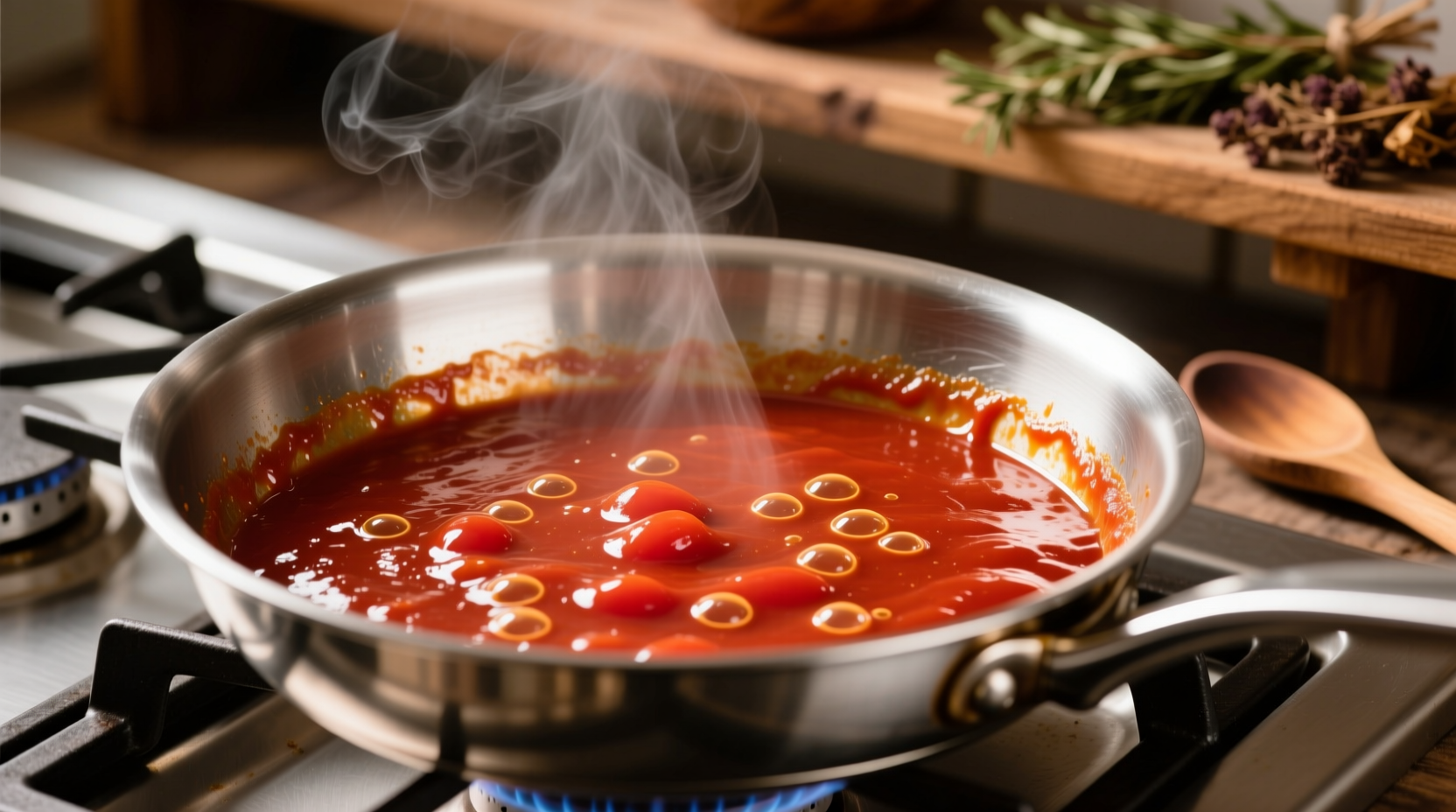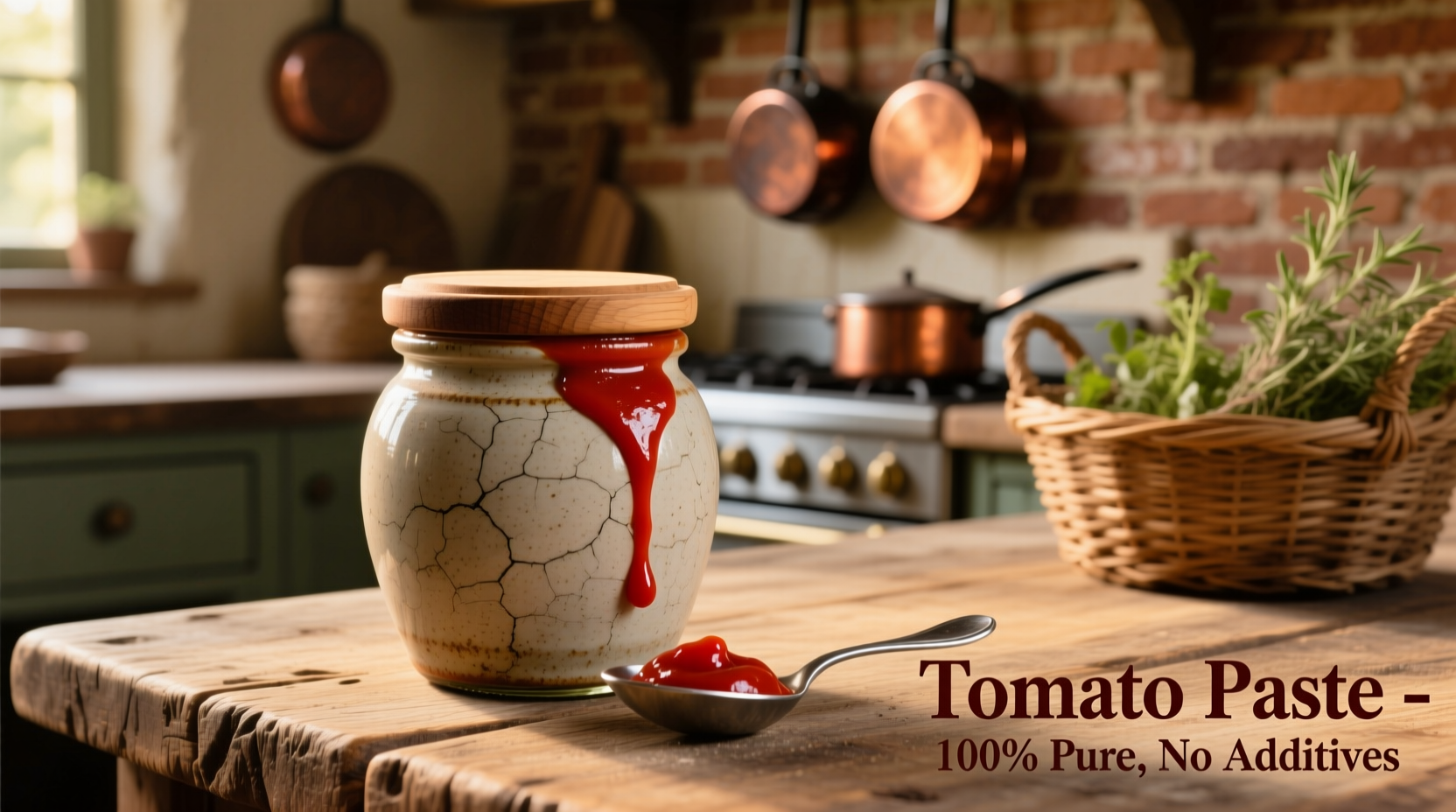If you need tomato paste but only have tomato sauce, you can substitute them with one simple adjustment: simmer 1½ cups of tomato sauce down to ¼ cup to replace 1¼ cups of tomato paste. This concentrates the flavor and removes excess liquid, mimicking tomato paste's thick consistency and intense tomato taste.
Why Substitution Requires More Than a Simple Swap
Tomato sauce and tomato paste aren't interchangeable without adjustment. Understanding their fundamental differences prevents recipe disasters. Tomato paste undergoes extended cooking that concentrates flavor and removes 60-70% of its water content compared to tomato sauce, creating a richer umami profile essential for proper sauce development.
| Characteristic | Tomato Sauce | Tomato Paste |
|---|---|---|
| Water Content | 94-95% | 55-60% |
| Solids Concentration | 5-6°Brix | 24-28°Brix |
| Flavor Intensity | Mild, balanced | Concentrated, caramelized |
| Typical Use | Base for soups, quick sauces | Flavor foundation, color enhancer |
The Step-by-Step Substitution Process
Follow this professional kitchen method for reliable results when substituting tomato sauce for tomato paste:
1. Measure and Reduce Properly
For every ¼ cup of tomato paste required, start with 1½ cups of tomato sauce. Simmer uncovered in a heavy-bottomed pan over medium-low heat for 20-25 minutes, stirring occasionally to prevent scorching. The sauce has reduced sufficiently when it mounds slightly when dropped from a spoon.
2. Adjust Seasoning After Reduction
As liquid evaporates, flavors concentrate. Wait until reduction is complete before adding salt or additional seasonings. The USDA's FoodData Central confirms that reducing tomato sauce increases sodium concentration by approximately 300%, so taste carefully before adjusting.
3. Incorporate at the Right Stage
Add your reduced tomato sauce substitute during the same cooking phase as tomato paste would normally be added—typically early in the cooking process to allow flavors to meld. Adding it too late prevents proper flavor integration.
When Substitution Works Best (and When It Doesn't)
Not all recipes tolerate this substitution equally. Understanding context boundaries prevents culinary disappointment:
- Ideal for: Hearty stews, chili, and long-simmered sauces where additional liquid won't compromise texture
- Problematic for: Pizza sauces, where excess moisture creates soggy crust, or recipes requiring precise liquid ratios like soups
- Requires adjustment in: Baking applications like tomato bread, where moisture content affects dough structure
According to culinary research from the Culinary Institute of America, successful substitution depends on the recipe's total liquid content. In dishes with less than 2 cups of liquid total, reducing tomato sauce becomes essential for proper consistency.
Avoid These Common Substitution Mistakes
Professional chefs consistently identify these errors that compromise results:
- Skipping the reduction step - Using unmodified tomato sauce creates watery, under-seasoned dishes
- Over-reducing - Burning the sauce creates bitter flavors that can't be salvaged
- Using flavored tomato sauces - Garlic or herb-infused sauces alter intended flavor profiles
- Not accounting for added salt - Many commercial tomato sauces contain significant sodium

Storage Considerations for Both Ingredients
Understanding proper storage extends usability and prevents waste:
- Unopened tomato paste in tubes lasts 12-18 months; canned paste keeps 18-24 months
- Refrigerated opened tomato paste remains usable for 5-7 days
- Tomato sauce substitution batches can be frozen in ice cube trays for 3-month storage
- Label frozen portions with measurement (¼ cup cubes work perfectly for substitution)
Food safety data from the National Center for Home Food Preservation confirms that properly stored reduced tomato sauce maintains quality for up to 3 months in the freezer, making batch preparation worthwhile for frequent cooks.
When to Seek Alternative Solutions
Sometimes substitution isn't the best approach. Consider these alternatives when:
- You need immediate results (reduction takes time)
- Your recipe requires small quantities (less than 2 tablespoons)
- You're making delicate sauces where flavor precision matters
In these cases, consider using tomato powder (1 tablespoon powder = ¼ cup paste) or creating a quick paste by combining tomato sauce with tomato paste powder. For authentic Italian cooking techniques, the American Academy of Chefs recommends maintaining proper ingredient integrity when possible, noting that substitutions work best in hearty dishes rather than delicate preparations.
Frequently Asked Questions
Can I use ketchup instead of tomato paste in a pinch?
Ketchup makes a poor substitute due to added sugar (typically 4g per tablespoon) and vinegar, which alter flavor balance. For every 1 tablespoon of tomato paste needed, use 3 tablespoons of tomato sauce reduced by half rather than ketchup.
How much tomato sauce equals 6 ounces of tomato paste?
Six ounces of tomato paste equals approximately 3¼ cups of reduced tomato sauce. Start with 5 cups of regular tomato sauce and simmer until reduced to 3¼ cups, which takes about 35-40 minutes of careful monitoring.
Does substituting tomato sauce affect nutritional content?
Yes, substitution changes nutritional values. Reduced tomato sauce contains approximately 30% more sodium than equivalent tomato paste. According to USDA FoodData Central, 1¼ cups of reduced tomato sauce has 480mg sodium versus 360mg in 1¼ cups of tomato paste. Calorie content remains similar (about 60 calories per ¼ cup).
Can I use fresh tomatoes instead of tomato paste?
Fresh tomatoes require significant processing to match tomato paste. You'll need approximately 3 pounds of ripe tomatoes, peeled and seeded, then simmered for 2-3 hours until reduced to ¼ cup. This method works seasonally but lacks the caramelized depth of commercial paste due to different processing methods.











 浙公网安备
33010002000092号
浙公网安备
33010002000092号 浙B2-20120091-4
浙B2-20120091-4